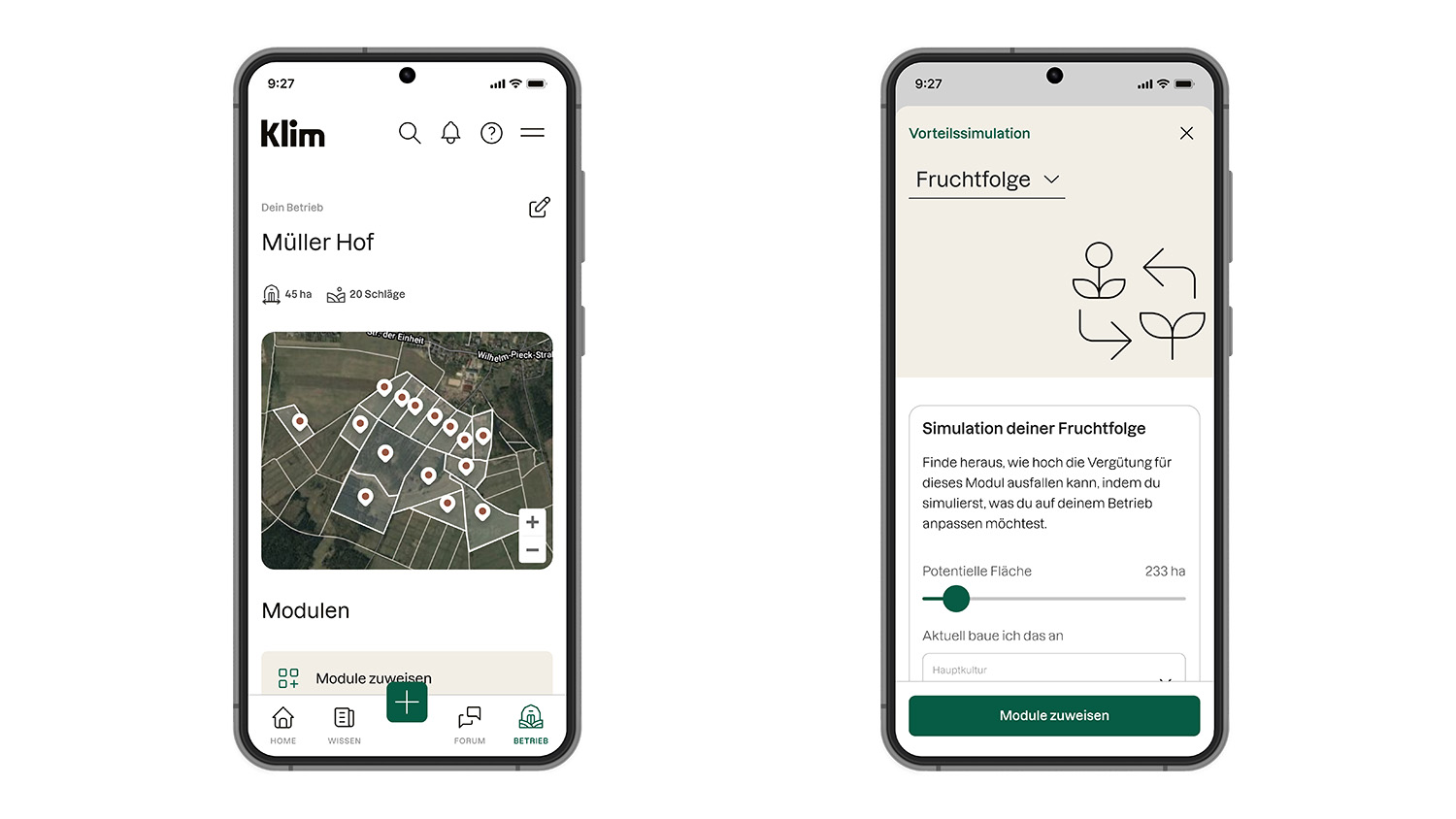It’s not uncommon for sustainability projects in Germany to fail because of complicated bureaucracy. Although there are state subsidies for sustainability services, they aren’t always implemented consistently. It can also be so complicated to provide evidence of your project that smaller farms with fewer staff don’t bother. But now, the Klim smartphone app is here to make regenerative agriculture as uncomplicated as possible.
2024’s agricultural diesel debate showed just how critical the discussions about subsidies and surcharges in agriculture are. Experts including Dr Sonoko Bellingrath-Kimura are calling for simpler incentives from politicians to make an agricultural transition more attractive for farms. In an interview with RESET, she called for measures that farms can understand, which aren’t imposed from the “top-down”.
While developing their app, Klim used this insight to focus on three aspects that would best meet the needs of farmers.
Autonomy, planning security and less bureaucracy
The Klim app is available for farmers to download free of charge on iOS and Android. Farmers can also use Klim in their browsers without installing anything. At the platform’s launch in 2021, Klim’s Head of Agriculture Lutz Wildermann identified three aspects of the app that are especially important to farmers: “The autonomy over their own actions, planning security and as little bureaucracy as possible.”
Registering with Klim isn’t much different from other apps. Users create an account, verify their email address and enter the size of their farm. The app will then show them various methods of regenerative agriculture. They can decide for themselves which regenerative agriculture tools should be used in which areas.
To help users decide on an appropriate procedure, the app offers simulation data that lets users try out various tools. This makes sure that the procedure works before it’s introduced. For example, the app calculates how certain crop rotations reduce or increase CO2 emissions. If you cultivate winter wheat after sugar beet, you’ll offset CO2 emissions, while following silage maize with a flowering field increases CO2 emissions. Klim also offers the Soil+ programme, which makes these changes as transparent as possible.
Soil+ reduces CO2 and improves soils
Soil+ is a programme for holistic field assessment that involves storing CO2 in the soil as well as reducing it on the field and in the barn. As of April 2024, Soil+ consists of four modules. These modules help farms decide for themselves whether they prefer to optimise their crop rotation, crop fertilisation, crop protection, or tillage and sowing.
Farms can also apply the lessons from the four modules to smaller areas. In order to work more regeneratively, the methods don’t have to extend to the entire farm. Klim remunerates each procedure farmers take from the four modules. In the future, Klim plans to provide a milk module that farmers can use to optimise processes in the dairy barn; the company is currently building out this module.
Companies can learn exactly how to efficiently implement each method of regenerative agriculture through Klim’s database of explainer articles. These are integrated into the Klim app and are available to companies free of charge. If more questions arise, Klim also offers individual coaching sessions, finding a solution for farmers through one-to-one meetings with members of the Klim team.
Farms can also share their experiences with other Klim users in a forum, making the Klim app an interface for the more than 3,500 regenerative farmers who are already registered on the platform.
Farmers receive premiums from CO2 offsetting funds
Klim compensates farmers via environmental impact funds, which, among other things, receive money from companies that take part in CO2 offsetting programmes. To offset their negative environmental impact, these companies make compensation payments per tonne of CO2 that aid the transformation of the agricultural industry. This money then gets passed on by Klim to agricultural businesses.
According to Lutz Wildermann, the advantage of Klim for companies is that “the value chain pulls together and works on improving the carbon footprint of the agriculture and food sector.” It also enables other industries to support regenerative agriculture. Klim gives the offsetting companies CO2 certificates while ensuring farmers receive financial support for carrying out CO2 offsetting practices. They also support the strengthening of biodiversity alongside carbon sequestration.
Agriculture is facing major challenges: on the one hand, it is severely impacted by biodiversity loss and the effects of climate change. On the other, agriculture itself massively contributes to these issues.
How can digital solutions on fields and farms help to protect species, soil and the climate?
We present solutions for a digital-ecological transformation towards sustainable agriculture. Find out more.
How can digital solutions on fields and farms help to protect species, soil and the climate?
We present solutions for a digital-ecological transformation towards sustainable agriculture. Find out more.
Remuneration is paid out once a year in November.
Farmers upload evidence via the app to receive compensation
Klim also focuses on the needs of farmers when it comes to verification. Farmers can find a verification portal in the Klim app, which they can use to digitally upload evidence and documents. This not only makes it easy to provide evidence but also allows Klim to easily check up on how various measures are being implemented. Klim has also begun using satellite data to verify some of these management practices.
The Klim app shows how digital solutions can help create more sustainable agriculture systems. The app doesn’t only make knowledge about sustainable farming methods more accessible but also incentivises farmers to introduce these practices on their own farms. For farmers, the financial benefit is immediate, and after consistently implementing regenerative farming methods, they’ll see better yields and soil health in the long term.
The post The Klim Mobile App: Making Regenerative Agriculture Simple and Lucrative appeared first on Digital for Good | RESET.ORG.


